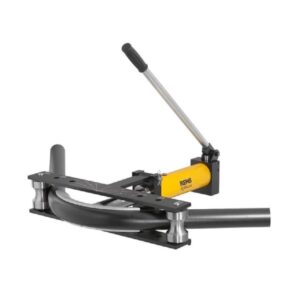If you’re doing a lot of DIY plumbing, you should be familiar with pipe bending.
And while you can also accomplish the task with a pipe bending spring, a pipe bender will make your life a whole lot easier.
So, if you’re wondering ‘how do you use a manual tube bender?’, you’ve come to the right place!
Here at Plumbing Superstore, we’re going to show you exactly how to use a pipe bender like a pro and make extremely neat bends.
Let’s dive right in.
Table of contents:
Pipe bender machine vs pipe bender spring
If you only need to bend smaller 15mm pipes intermittently, you might be fine with a simple pipe-bending spring. However, anything larger than that, such as the commonly found 22mm or 26mm sizes, requires a pipe bender.
Keep in mind that, even with the smaller size, prolonged use of a bending spring might cause long-term injuries to your knee.
So, a steel or copper pipe bender is a solid, long-term investment which will save you time and effort and help you avoid injuries.
How do you use a copper pipe bender?
There are different types of bends, including a 90° stub up bend, back-to-back bend, offset bend and three-point saddle bend. However, the 90° bend, also known as an ‘L shape bend’, is the most common one found in plumbing and electrical applications and the one we’re going to focus on.
So, how do you bend a pipe with a pipe bender?
To find out how to bend a copper pipe to 90°, follow these steps.

Step 1: Prepare the pipe
Measure the location of the pipe where you want to make the bend and mark it with a pencil or marker.
Step 2: Insert the pipe
Open the handles of the copper pipe bending tool fully and carefully place the pipe in the appropriate size former (i.e., 15mm former for a 15mm pipe, 22mm former for a 22mm).
Step 3: Secure the pipe
Flip the holding clamp to the end of the tube so it holds it down firmly while you make any required small adjustments. Then, slot in the guide between the tube’s top and the handle.
Step 4: Bend the pipe
Pull down the top handle carefully to bend the pipe to the required angle, in this case, 90°. Use a square to check if the angle is correct. Then, continue copper bending slightly over the angle because the pipe will spring back slightly once it’s released.
Step 5: Remove the pipe
Disengage the holding clamp, open the handles of the copper pipe bender and remove the pipe. To make any further bends, repeat the above steps.
That’s it! Nice and easy
The bottom line
Bending pipes instead of using joints or elbows can save you time and money. And if you’re doing a lot of it on a regular basis, you need a proper plumber’s pipe bender.
The good news is:
These handy tools are very easy to operate. And now that you know how to use a pipe bender, you can make steel and copper bend angles of anywhere between 0° and 135° quickly and with the least amount of hassle.









